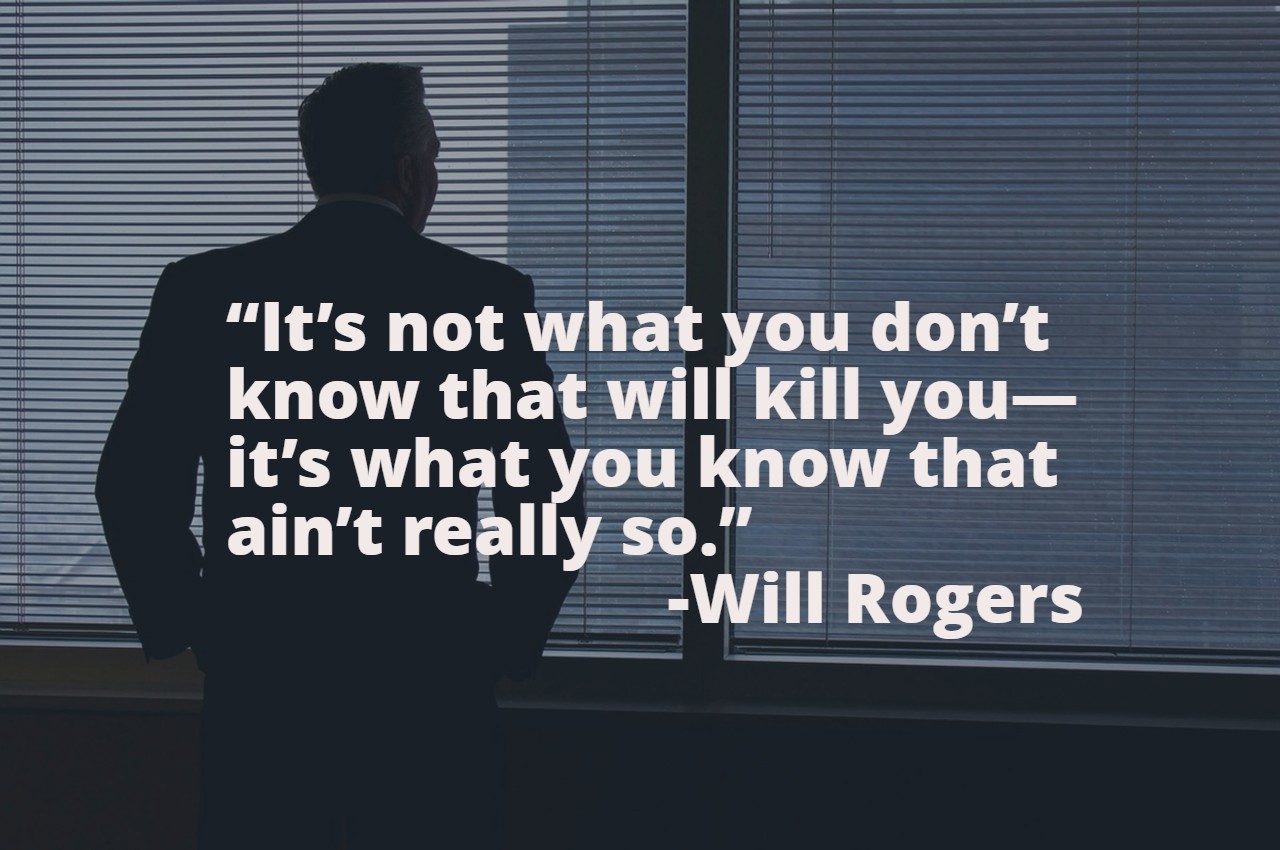Will Rogers once quipped, “It’s not what you don’t know that will kill you—it’s what you know that ain’t really so.” I have often said, “I read it on the internet, so it must be true!”1
In the digital age, we are subject to a high amount of information transmission and are likely to pay unequal attention to supportive information and, consequently, have more polarized opinions.2 Despite diverse information available in our networks, we may selectively focus on subsets of the entire information.
Confirmation bias, or “positive testing strategies” describe our unconscious tendency to attach more weight than we should to information that is consistent with our beliefs, hypotheses, and recent experiences and to discount information that contradicts them.3 We are naturally wired to want to prove our beliefs and hypotheses, rather than wanting to disprove them. There is a certain “comfort” in being correct. Unfortunately, confirmation bias also leads us to disconfirmation bias2 – where we tend to more thoroughly scrutinize information that is inconsistent with our current positions.
The leads to the “illusion of knowledge”4 when a someone becomes overconfident about having access to a greater amount of information, but makes poor decisions, despite the additional information. This was detected when investors who had switched from a phone-based investing method to an online trading platform became more confident, and yet recorded poor performance despite having access to more information.
Perhaps the massive amounts of information at our disposal leads to questionable decisions. Additionally, holding on to beliefs that may not be true could lead to others eventually questioning your judgment.
Has the Digital Age Retarded Our Ability to Critically Think?
Google stores and can anticipate our search patterns. LinkedIn and Facebook “suggest” connections we may be interested in. When we “Like” something on Social Media we may be creating an ecosystem of shared beliefs that skews our objectivity and decision making.5 Could all this promote unconscious confirmation bias and poor decision making despite having the necessary information to make an educated one? One cannot escape the irony.
The need for good old-fashioned critical thinking skills are therefore more important in the digital age than at any other time in history. Lacking critical thinking skills, humans tend to find evidence supporting their argument even when there is none to be found or there is evidence to the contrary.
Critical thinking is not just about “thinking a lot.” According to The Critical Thinking Community:
“Critical thinking is the intellectually disciplined process of actively and skillfully conceptualizing, applying, analyzing, synthesizing, and/or evaluating information gathered from, or generated by, observation, experience, reflection, reasoning, or communication, as a guide to belief and action.”
Lacking good critical thinking, we are unconsciously practicing positive testing strategies. The social scientist Karl Popper advocated disproving instead of proving our hypotheses. The “discomfort” of attempting to prove ourselves wrong promotes the traits of good critical thinking.
A digital ready organization must practice good critical thinking. Its members should possess the following skills:6
- Interpretation and Categorization – understanding the meaning or significance of a wide variety of experiences and data
- Analysis – identifying the relationships in all the information
- Interpretation – comprehending the significance of all the information
- Evaluation – assessing the credibility of the information and of any relationships
- Infer – identifying elements needed to draw reasonable conclusions from the relevant information
- Explain – being able to present in a coherent way the results of one’s own reasoning
- Self-regulating – self-consciously to monitoring one’s thought processes
Without these important characteristics, we are missing the real value to the information available to us in the digital age. Practice these skills to make your organization digital ready.
Sources:
1Boyd, D. (2013). Innovation Savvy. Leadership Excellence Essentials, 30(7), 9-10.
2 Lee, J. K., Choi, J., Kim, C., & Kim, Y. (2014). Social media, network heterogeneity, and opinion polarization. Journal of communication, 64(4), 702-722.
3Nickerson, R. S. (1998). Confirmation bias: A ubiquitous phenomenon in many guises. Review Of General Psychology, 2(2), 175-220. doi:10.1037/1089-2680.2.2.175
4Hsu, J. S., Huang, H., & Linden, L. P. (2011). Computer-mediated counter-arguments and individual learning. Journal Of Educational Technology & Society, 14(4), 111-123.
5Halpern, D., & Gibbs, J. (2013). Social media as a catalyst for online deliberation? Exploring the affordances of Facebook and YouTube for political expression. Computers in Human Behavior, 29(3), 1159-1168.
6Facione, Peter A. “The Future: Creativity, Critical Thinking and Mindfulness.”Educating the More Able Student: What Works and Why (n.d.): 204-07.The University of Western Australia. Measured Reasons and The California Academic Press. Web. 12 Sept. 2016. http://www.student.uwa.edu.au/__data/assets/pdf_file/0003/1922502/Critical-Thinking-What-it-is-and-why-it-counts.pdf
About the Author:
Tag/s:Digital Era





